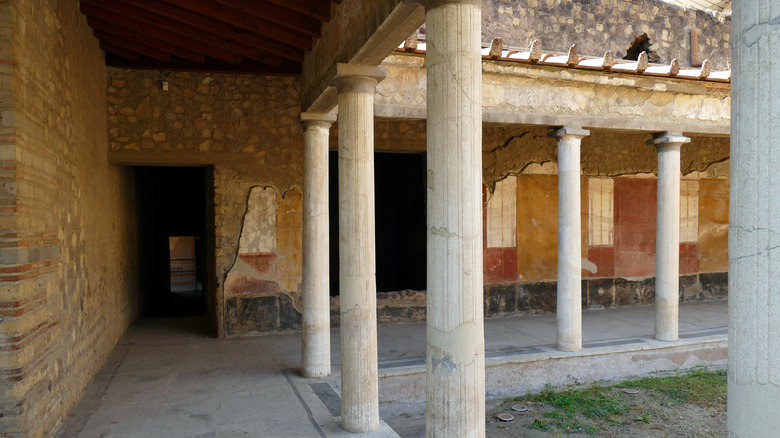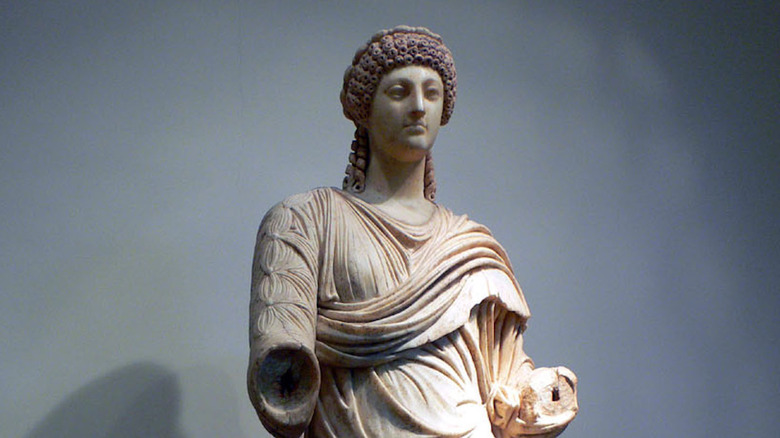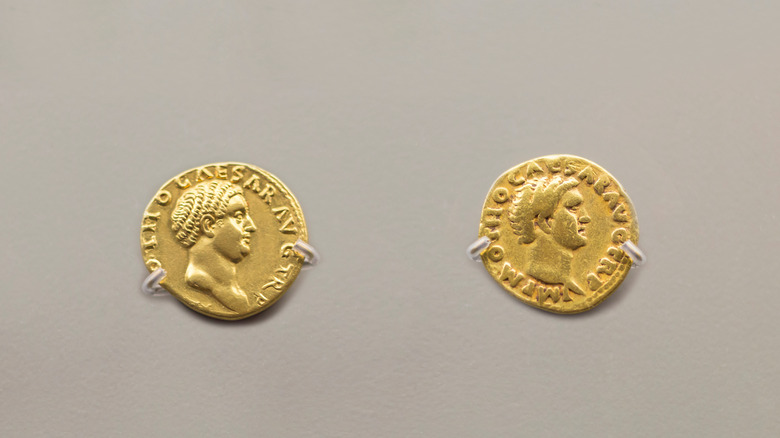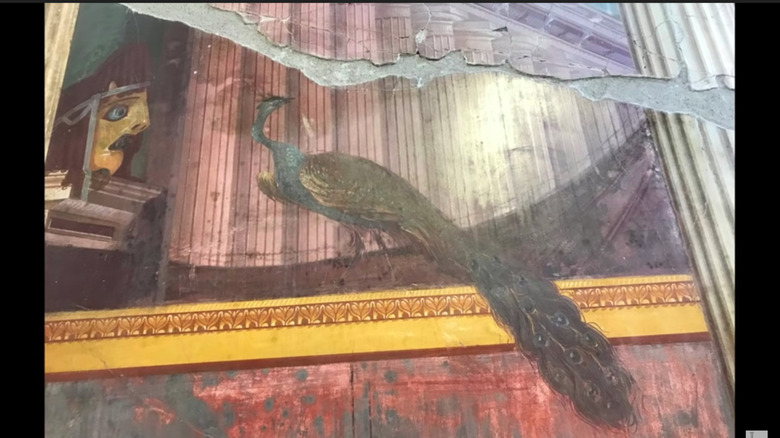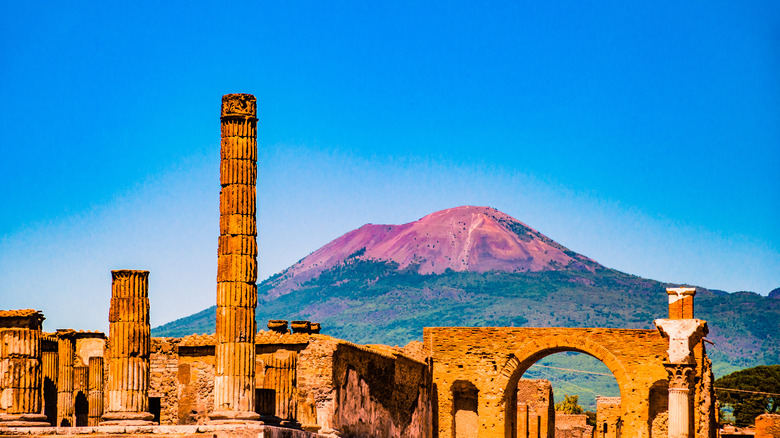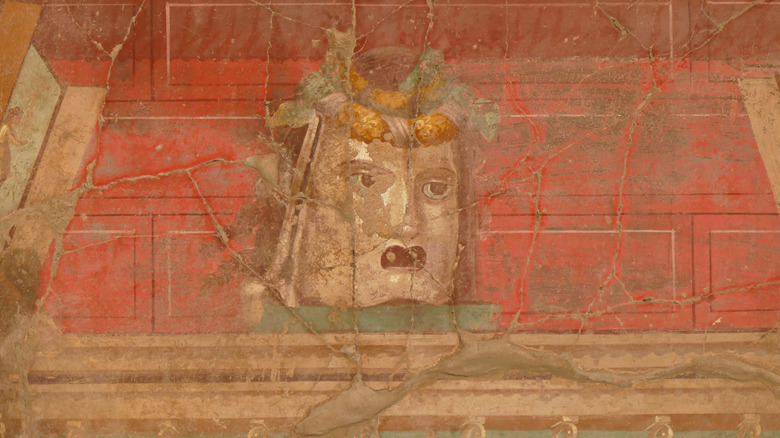Nero's Mistress May Have Lived In This Pristinely Preserved Villa Buried By Vesuvius
The villa was opulent by any standards, with around 100 rooms and strikingly painted walls. It was fit for royalty, and it may well have been where the girlfriend of none other than Roman Emperor Nero lived. Villa A — or Villa Poppaea, as it is sometimes called — is in Oplontis, Italy. Like nearby Pompeii, it was buried by the eruption of the volcano Mount Vesuvius in A.D. 79.
Only about half the villa has been excavated so far, and it is the only site in Oplontis open to visitors (via Pompeii Sites). As National Geographic wrote in 2021, the part that has been uncovered includes a large, Tuscan-style atrium (or entrance) that once contained a shallow pool. It is surrounded by living and dining rooms. Elsewhere are three rooms for private baths: one hot, one warm, and one cold. Archaeologists have also unearthed slave quarters and guest rooms. They can tell that the villa underwent several expansions, the largest of which added a long pool that was once surrounded by statues, according to the travel, history, and culture YouTube channel Told in Stone.
But considering the historical tragedy that looms over Pompeii and its surrounding areas, whatever became of the woman, Nero's mistress, who lived inside it? And is her fate tied to the villa she called home? Or is it possible she never even lived there at all?
Who was Poppaea Sabina?
Before diving too deeply into whether Villa A in Oplontis, Italy has any ties to the woman who would become Emperor Nero's second wife, it would help to learn a little about her first. In general, Poppaea Sabina is known for her connections to various men. She was the granddaughter of Roman consul Gaius Poppaeus Sabinus, who also governed Moesia, a Roman-occupied area in the southeastern Balkan region (via Britannica). Her family's ties to political power didn't stop there; Poppaea's father, Titus Ollius, was a quaestor (or a financial official), per the Roman historian Suetonius.
Poppaea was married three times before Emperor Nero, her final husband. The first was to a Roman official named Rufrius Crispinus — and who, in a sardonic twist, was later executed by Nero, per Oxford Reference. Her second was to Otho, one of Nero's cohorts, who forced Otho to divorce Poppaea. For what it's worth, Poppaea and Nero were already in the midst of an affair (via ThoughtCo); By around 58 A.D., she was Nero's mistress, and Poppaea and Nero tied the knot in 62 A.D.
As a historical figure, Poppaea has remained controversial. Supposedly, she influenced Nero to execute his mother, Agrippina, his first wife, Octavia, and the philosopher Seneca (via The Latin Library). While the historian Tacitus painted an unflattering picture of Poppaea, the Jewish historian Josephus called her that she was a "god-fearing" woman who interceded on behalf of the oft-persecuted Jews in the Roman empire at least twice (via the Encyclopedia).
How did Poppaea Sabina die?
A number of accounts about Poppaea Sabina (pictured above on the coin on the right) recorded she died after Emperor Nero (pictured on the left coin) kicked her in the belly while she was heavily pregnant with their second child. According to the Roman historian Suetonius, this happened "only because she found fault with him for returning late from driving his chariot." Suetonius, who according to Britannica was born in 69 A.D. (i.e., a few years after the deaths of both Nero and Poppaea), also wrote of Nero that "there was no person at all connected with him who escaped his deadly and unjust cruelty."
However, University of Geneva Professor Paul Schubert noted in a 2021 write-up of Poppaea that the same accusation — killing a pregnant woman by kicking her — was leveled at several ancient kings, so it may not be true (via the Antigone Journal). Per Schubert, there's another legend associated with Poppaea's death and recorded in a poem found on scraps of papyrus in Oxyrhynchus, Egypt. In the poem, the goddess Aphrodite comes in her chariot to visit a young, pregnant woman and tells the woman she must come live with the gods. Though reluctant, she ultimately goes with Aphrodite — but only after making a farewell speech to her husband. This poem is believed to be about Poppaea due to several references to Nero, per Schubert, and the poem's existence also implies that perhaps Poppaea, and even Nero, were more favorably looked upon by the Romans than previously thought.
What is the Villa Poppaea most known for?
Considering Poppaea Sabina's reputation during and after her life, it's no surprise a villa possibly associated with her outside of Pompeii — one destroyed during the infamous eruption of Mount Vesuvius, no less — would drum up interest in historians, archaeologists, and tourists alike. However, even without the possible ties to Emperor Nero's second wife, the ancient site itself is a veritable treasure trove of information about the lives of ancient Romans, and dazzlingly so.
Since its excavation, Villa A (or Villa Poppaea) has been best known for the vivid frescoes on its walls. Many of these have survived the centuries remarkably intact. In the atrium, the walls are decorated with paintings of columns and doors, to make the place seem more palatial, per the YouTube channel Told in Stone. A salon that once opened onto a terrace — one with a huge fresco of another columned building with peacocks perched around it — was meant to suggest "exotic splendor," according to the history-centric web series. The villa's baths were decorated with scenes from Greek mythology.
Other parts of the house were less elaborately decorated. One courtyard garden's walls were simply painted red. Elsewhere, striped walls around another courtyard indicate that this particular part of the house was probably the slave quarters, where decorative elements were deemed unnecessary, per their social status. Nearby guest rooms feature miniature paintings on the walls, the style of a different era than the atrium and salon (via Told in Stone).
What happened at the villa when Vesuvius erupted?
The reason the villa many have linked with Poppaea Sabina was perfectly preserved in the ash and nuclear-level heat of the volcano known as Vesuvius. In 79 A.D., Mount Vesuvius erupted, burying the cities of Pompeii and Herculaneum, as well as nearby Oplontis. A 10-mile cloud covered the area, while volcanic ash and pumice stone fell on Pompeii and the surrounding areas. Those who survived this onslaught died the next day when a cloud of noxious gas fell over the city. Herculaneum survived the initial few hours of the catastrophe but was burned and buried later. Oplontis suffered a similar fate (via the History Channel).
Seismic activity leading up to this event had damaged the Villa Poppaea, so it was under construction to repair that damage when the eruption occurred, according to Pompeii Sites. Only workers would have been at the house, and the lack of human remains at the site indicates they were able to escape, per Told in Stone. The construction also meant that many decorative items such as statues had been taken out of the house and probably survived the eruption. The rest of the villa remains preserved, a window into another time.
Why do people think the villa belonged to Nero's second wife?
So the question remains: Even though the archaeological site of Villa A in Oplontis, Italy, is purportedly connected to Poppaea Sabina, is this actually the case? Apparently, there's enough circumstantial evidence to support the theory, at the very least. Emperor Nero's second wife was originally from Pompeii, which may be why she later lived in nearby Oplontis (via Oxford Reference). In addition to this, an amphora –- a type of jar -– found at this villa bears the name of Secundus, one of Poppaea's slaves or freedmen, which could suggest that the villa belonged to Poppaea, per Pompeii Sites.
Even so, there's a chance she couldn't have been the sole owner because the villa was built in the mid-first century B.C. That means the villa itself would have been around 100 years old at the time of her death — so it's a lot more likely that the may have originally belonged to one of her family members, but not Poppaea exclusively. (That being said, Nero is believed to have visited her at the villa in A.D. 64, per Told in Stone.)
